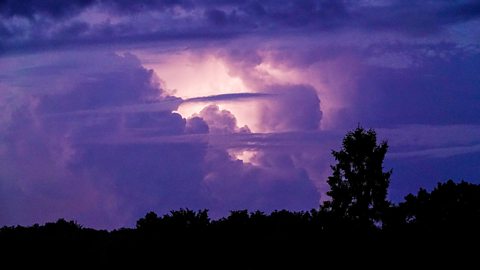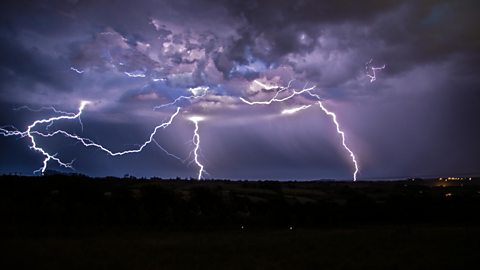What is a thunderstorm?
Thunder and lightning can be exciting and sometimes a little scary but what is a thunderstorm?
In this article you can learn:
- What causes thunder and lightning
- What static electricity is
- Different types of lightning, like sheet or ball lightning
This resource is suitable for weather topics for primary school learners.
Video - What is a thunderstorm?
Watch this video to learn about thunder, lightning and static electricity.
Thunder rumbling noises
Have you ever been in a thunderstorm?
The heavy rain, bright flashes of lightning, and the crashing and rumbling sounds of the thunder. It’s very exciting. Maybe even a bit scary.
But what is a thunderstorm?
It’s a little like the shock you get when you shuffle on a carpet and touch a door handle. Or when your hair sticks to a balloon when you rub it on your head. Both of these are caused by static electricity. And that’s what causes thunderstormstoo.
Thunderstorms start in clouds. Inside a storm cloud, bits of ice move up and down and bump into each other. And just like when you rub a balloon this builds up an electric charge…
but a much bigger charge.
If the charge builds up enough, it flows as a massive electrical current to the ground or to another cloud. This is like a shock or a really big spark and is what we call lightning.
There are lots of different kinds of lightning. The most common is sheet lightningwhich flows between clouds and lights up the whole sky. There’s also fork lightning which flows between a cloud and the ground. And even ball lightning.
When lightning happens, it heats the air to around 10,000 °C. As the air heats so quickly it suddenly expands, making a shock wave – a huge vibration in the airthat we hear as thunder.
We usually see lightning before we hear thunder. That’s because light and sound travel at different speeds. The lightning flash travels very fast, but the sound of thunder travels much more slowly. And the further away you are, the longer thetime between the lightning and the thunder.
You can work out how far away a thunderstorm is by counting the number of seconds between the flash of lightning and the sound of thunder and then divide that number by 3. This will give you the distance in kilometres.
So the next time there is a thunderstorm try working out how far away it is. But do this indoors where you’ll be much safer.
Where do thunderstorms come from?
- Thunderstorms start inside a cloud.
- Bits of ice move up and down and bump into each other inside the cloud.
- This builds up an electric charge.
- If the charge builds up enough it can suddenly flow as a massive electrical current between the cloud and the ground, or between clouds. We see this as a really big spark and it's what we call lightning.
- When lightning happens, it heats the air to around 10,000°C.
- The air heats up so quickly that it suddenly expands creating a shock wave, a huge vibration in the air, that we hear as thunder.
Lightning comes from an electrical charge. Want to learn more about electricity? What is electricity?
Real life examples of lightning
This slideshow shows photographs of different types of lightning:
- sheet lightning
- fork lightning
- ball lightning

Image caption, Sheet lightning
Sheet lightning happens when an electrical charge builds up inside a cloud and flows from one cloud to another. It is a bright flash that fills the sky.

Image caption, Fork lightning
Fork lightning is what we often think of when we imagine lightning. It is an electrical charge that flows from a cloud down to the ground in a zig-zag path.

Image caption, Ball lightning
Ball lightning is a very strange and unusual type of lightning which looks like a glowing ball of light. Scientists cannot explain why it happens and it is very rare!
1 of 3

Keys words about thunder and lightning
- thunder - A shock wave, a huge vibration in the air, that we hear as a loud rumbling sound.
- lightning - A bright light in the sky. It is caused by so much static electricity building up inside a cloud that giant spark of electricity flows between the cloud and the ground or between clouds.
- static electricity - When two different materials rub against each other and they become electrically charged. For example, rubbing a balloon on your head or bits of ice bumping together inside a cloud.
- shock - When an electrical current flows through someone’s body.
- shock wave - A sudden burst of energy that moves out in waves, shaking the air around it.
- sheet lightning - Lightning which flows between clouds and lights up the sky.
- fork lightning - Jagged lightning with flows between a cloud and the ground.
- ball lightning - This is a very rare and unusual type of lightning. It is lightning in the form of a glowing electric ball.
Test your knowledge
Quiz
Challenge

Create static electricity with a balloon.
Thunder and lightning are caused by static electricity - when two different materials rub against each other.
Try your own static electricity experiment at home or in the classroom.
You will need:
- a balloon
- a dry cloth
What to do:
- Rub the surface of the inflated balloon with a piece of cloth for about 40 seconds.
- Hold the balloon above your head (not touching) and watch your hair stick to it. This is caused by static electricity.

More on Weather
Find out more by working through a topic
- count10 of 24

- count11 of 24

- count12 of 24

- count13 of 24
